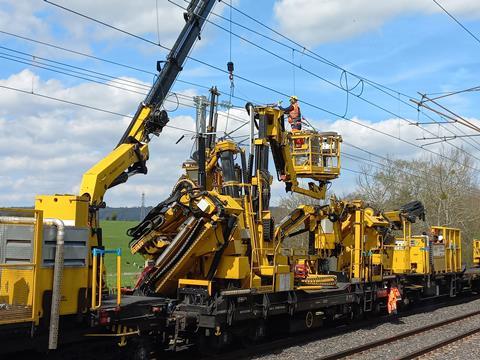
FRANCE: Faced with the prospect of renewing a substantial proportion of the overhead line equipment across the national railway network, SNCF Réseau has announced its intention to procure a third catenary renewal train.
The infrastructure manager has recently put into service two highly automated machines, (known in French as suites rapides caténaires), and presented its initial experience with their operation at the recent SIFER trade fair in Lille.
SNCF Réseau has seen a steady increase in catenary-related incidents and delays since 2010, many of which it attributes to the age of the OLE on its conventional main lines. The average age of the electrification on the 1·5 kV DC routes in the south and east of the country is now around 75 years, while the more recent 25 kV 50 Hz network in the north has an average age of 43 years.
Citing the need to renew overhead lines faster, as well as the incompatibility of traditional renewal methods with modern health and safety regulations and the need for greater network availability, SNCF Réseau began to look for innovative ways to industrialise the renewal process. Given that suppliers had been able to develop high-performance machines for track renewals, the infrastructure manager felt that it should be possible to take a similar approach to catenary replacement.
In 2016, SNCF Réseau signed an agreement with maintenance contractors TSO Caténaires and Colas Rail covering the development and deployment of new technology, in what it said was a world première. Two machines have been built by Geismar and Novium — one for use on DC routes and the other for the AC network.
The DC renewals system in fact uses two separate formations. One is designed for removing the existing overhead lines and the second for installing new equipment. On the oldest 1·5 kV DC routes, many of the masts and gantries are badly corroded and in need of complete replacement. The sequential process allows the new catenary supports to be installed in the same position as the old ones that they are replacing.
On the 25 kV routes, only the wires and support arms are being replaced, rather than the whole masts. In part, this work is intended to bring the catenary in line with the latest TSI standards for 160 km/h operation. This renewal unit is able to replace either single and double supports as required, with a maximum spacing of 63 m.
The 25 kV renewal train was launched in 2019, and up to March 2023 it had replaced 12 000 supports. The 1·5 kV train was launched in 2021, and by March 2023, it had replaced 3 000 overhead masts and the associated wiring. In general, SNCF Réseau estimates that the deployment of the two machines has improved productivity by a factor of four or six, depending on the routes involved and the condition of the equipment.
The 25 kV train is currently being deployed to renew the OLE on the Neufchateau – Barisey section of the European Rail Freight Corridor 2 in eastern France. This renewals project is costed at €5m, and is being fully funded by the infrastructure manager. During a visit by Railway Gazette International, the machine was replacing 23 support arms per day, covering approximately 1 km in each working session. In full operation, the train requires a team of 70 people, of which 20 are from SNCF Réseau and 50 from TSO Caténaires and Colas Rail.
According to SNCF Réseau, the reason for procuring a third machine is to increase the volume of catenary being replaced. The move reflects recent government policy to increase investment in infrastructure renewals as part of its national railway plan. The infrastructure manager is worried about the potential delay to completing the work, warning that this would be ‘unbearable’ for the whole railway sector.
Based on experience with the first two units, SNCF Réseau is looking to improve the reliability of the machines. It is also keen to find ways of working which do not disrupt commercial operations, especially on the 1·5 kV DC corridors where there are few suitable diversionary routes.

















